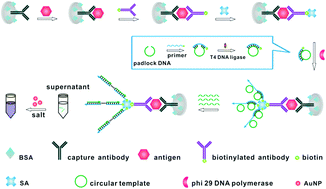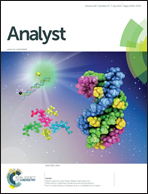Sensitive colorimetric detection of protein by gold nanoparticles and rolling circle amplification†
Abstract
An ultrasensitive method for the detection of protein is critically important in fundamental research and practical applications due to the low abundance of disease markers in body fluids or tissues. To detect the trace levels of disease markers with high sensitivity and specificity, a sensitive colorimetric biosensor for protein assay was developed using gold nanoparticles (AuNPs) and rolling circle amplification (RCA). After binding the biotinylated primer/circular template to the streptavidin-conjugated sandwich ELISA immunocomplex, the biotinylated primer was isothermally extended to generate single-stranded DNA (ssDNA). Sequentially, the padlock DNA was added and hybridized with the RCA products. The aggregation of the additional AuNPs in the supernatant containing the surplus padlock DNA and a certain concentration of salt could then be observed. The established sensor allowed for the specific detection of α-fetoprotein (AFP) with a detection limit of 33.45 pg mL−1. It was also demonstrated that this method could distinguish 500 pg mL−1 AFP with the naked eye. In addition, this biosensor could be applied to complex sample analysis and could be further used as a universal method for any protein or virus determination by changing the corresponding antibodies.


 Please wait while we load your content...
Please wait while we load your content...